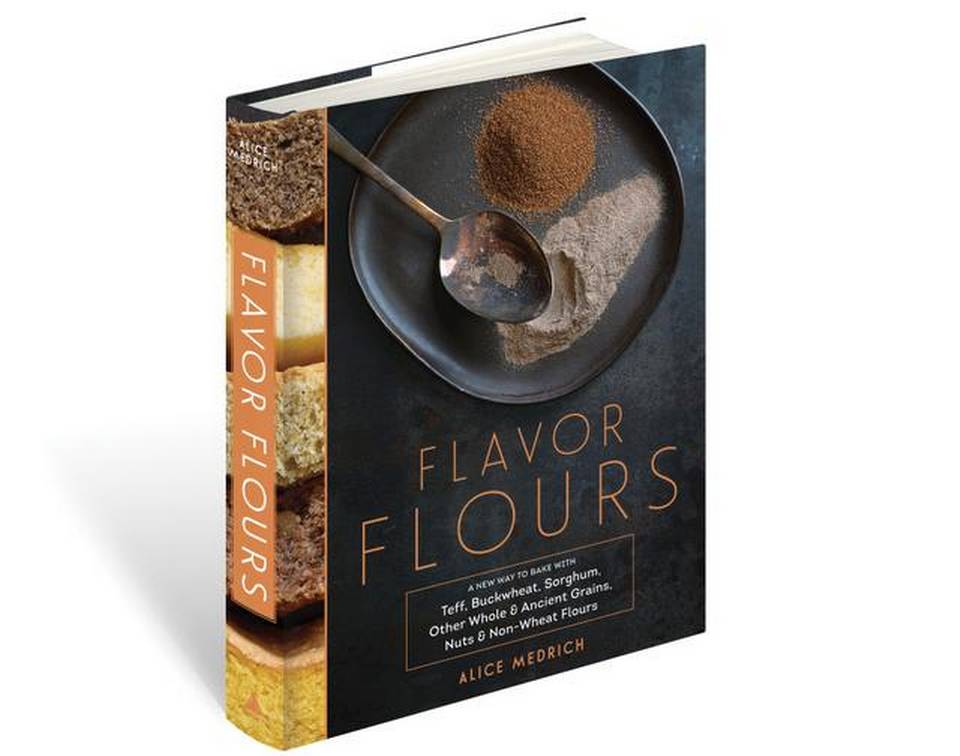Baking has always been a passion of mine and I’ve counted on Alice Medrich for decades for her clear, foolproof, and, most of all, delicious recipes at home and when I worked as a pastry cook. Her latest book, Flavor Flours, is full of meticulously developed recipes which you, too, can replicate thanks to Alice’s walking you through step by step.
The name, Flavor Flours, refers to Medrich’s feeling that whole grain flours are delicious in their own right, not something to add just as a healthy supplement. New, delicious flavors stimulated her creativity and the result is dozens of recipes featuring rice, oats, corn, sorghum, buckwheat, coconut, chestnuts and other nuts, which are all gluten-free.
Flavor Flours is organized by type of flour; rather than using an all-purpose blend as a substitute for wheat flour, these recipes use one or more of the flours to add flavor and texture in a meaningful way. The goal of the cookbook, in Medrich’s words, “is to celebrate the flavor of the flours, each one…treated as a hero.”
Medrich is a wonderful teacher; in this cookbook her voice is as authoritative and encouraging as ever, with cheerful revelations, such as: A lack of gluten can make baking less complicated. This is because mixing can be done in fewer steps without the need to inhibit gluten’s negative properties. She and Maya Klein – their baking partnership has existed for decades through many projects and books – tackled gingerbread, biscuits, donuts and crackers and more.
The gluten-free flours required exploration and experimentation, the results of which are discussed in the book. They use some techniques and ingredients typical to gluten-free baking, but, surprisingly, they were able to avoid the conventional use of xanthan gum or guar in génoise and chiffon-type sponge cake recipes; thoroughly beaten eggs provided more than enough structure.
Information about buying and storing flours ensures that you will make the most of your investment in perishable whole grain or nut-derived flours. There is crucial information about why it matters which brand of flours you choose. The ubiquitous “Bob’s Red Mill” rice flour is not as finely ground as “Authentic Foods” brand rice flour, which is not as finely ground as Thai rice flour. While this does not make a critical difference in some recipes, the textural difference is noticeable in puddings and pastry cream, which are satiny-smooth when made with the superfine Thai flour.
One of the recipes I tried from the book was Boston Cream Pie, which is not really a pie but a yellow two-layer cake with a pastry cream filling topped with chocolate glaze. The simple corn-and-rice-flour chiffon-type layers rose well and were tender, with a delicate hint of corn flavor. The pastry cream and chocolate glaze were both very easy to make; the plentiful, shiny glaze was a standout and, as suggested, leftovers made a great topping for ice cream.
The Dark Chocolate Soufflés was a recipe I experimented with a bit, out of necessity. I had been given some high quality chocolate which was 52% cacao, and having read Ms. Medrich’s tutorial on chocolate I knew it was important to make an adjustment to match the higher percentage. I deduced that if I used 3 ounces of 52% chocolate and 1 ounce of unsweetened chocolate I would be in the realm of the 4 ounces of 62% chocolate called for. As for the soufflés? These were one of the loveliest desserts I’ve had this cold, cold winter. They were quick to prepare and – contrary to soufflés’ reputation for “fiddly-ness”- could then be refrigerated for up to three days and baked straight out of the refrigerator, an easy and impressive party dessert. I served them dusted with powdered sugar alongside whipped crème fraiche
(another recipe from the book) and berries – heavenly!
This cookbook is a testament to Medrich’s attention to detail; it is visually beautiful and a complete, delicious guide to some new ingredients for many of us. Her sage advice, gleaned from painstaking research, and her enthusiastic coaching style communicate her love of baking and teaching in a most palatable way. ![]()
First published April 2015
